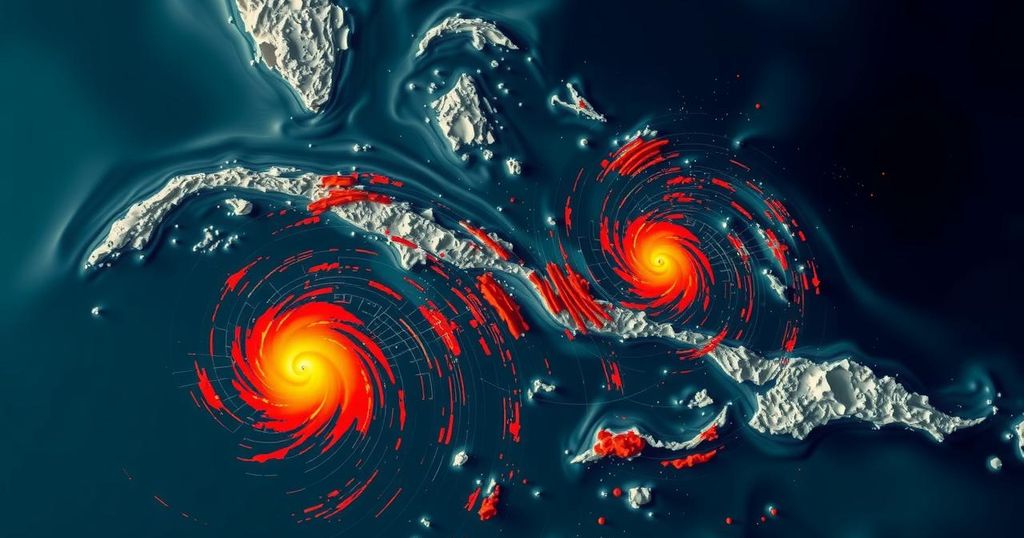World news
AFRICA, ANDREA RODRIGUEZ, AP, ARIEL LEY, ASSOCIATED PRESS, BARTOLOME MASO, CHILE, CUBA, EMERGENCY RESPONSE, GHANA, GUANTANAMO, HAVANA, HO, HOLGUIN, HURRICANE BERYL, JAMAICA, NATURAL DISASTER, NATURAL DISASTERS, NORTH AMERICA, PILON, POWER OUTAGES, RAFAEL, SANTIAGO, SANTIAGO DE CUBA, SOUTH AMERICA, THE ASSOCIATED PRESS, TRINIDAD & TOBAGO, US GEOLOGICAL SURVEY, YO, YOLANDA TABÍO
David O'Sullivan
0 Comments
6.8 Magnitude Earthquake Strikes Eastern Cuba Amid Ongoing Crises
A magnitude 6.8 earthquake rattled eastern Cuba, compounding the challenges following Hurricane Rafael and recent blackouts. Tremors affected several cities, including Santiago de Cuba, but immediate reports indicated no major injuries. The earthquake intensifies the hardships faced by residents amid ongoing energy crises and infrastructure concerns.
On Sunday, eastern Cuba experienced a significant earthquake registering a preliminary magnitude of 6.8. This seismic event follows a tumultuous period marked by hurricanes and extensive blackouts that have left the island’s residents in a vulnerable state. The earthquake’s epicenter was situated approximately 25 miles south of Bartolome Maso, as reported by the U.S. Geological Survey. Tremors were felt across various eastern regions, including larger cities such as Santiago de Cuba, Holguin, and Guantanamo, with reports of residents in Jamaica also experiencing the earthquake’s effects. In Santiago, Cuba’s second-largest city, residents reacted with alarm, retreating to the streets in a state of unease. Local resident Yolanda Tabío, 76, recounted how people flocked to their doorways in fear. Despite the chaos, she noted that no significant damage or injury was reported among her circle. “You had to see how everything was moving, the walls, everything,” she stated, reflecting the tremors’ intensity. Social media posts from the small town of Pilon indicated some minor structural damage, with images depicting crumbling roofs and wall cracks—an issue not uncommon in Cuba due to many older buildings in need of repair. This seismic activity comes on the heels of devastation caused by Hurricane Rafael, a Category 3 storm that struck Cuba earlier in the week, resulting in widespread power outages, damage to homes, and the evacuation of numerous people. Cuba’s struggles have been exacerbated over recent weeks due to persistent blackouts and dissatisfaction among citizens facing an energy crisis. This has spurred a wave of small protests across the island as people seek relief from ongoing challenges.
Cuba has been facing a series of natural calamities that have heightened its existing challenges, particularly energy shortages and deteriorating infrastructure. The recent earthquake adds to the stress of a population already grappling with the aftermath of Hurricane Rafael, which wreaked havoc just days prior, causing widespread destruction and power outages that have persisted across the island. The cumulative toll of these events on the Cuban population has led to increased unrest and dissatisfaction with the government’s handling of these crises. In many areas, people are particularly concerned about the vulnerability of their buildings, many of which are old and susceptible to damage from natural disasters.
In summary, the 6.8 magnitude earthquake that struck eastern Cuba has compounded the island’s current crises, following severe hurricanes and extensive blackouts. While immediate reports indicate limited damage, the ongoing state of vulnerability among Cuba’s aging infrastructure raises concerns for future seismic events. The situation reflects a broader narrative of struggle amidst natural disasters, fueling public discontent and highlighting the urgent need for improved response strategies to safeguard communities.
Original Source: tt.loopnews.com




Post Comment